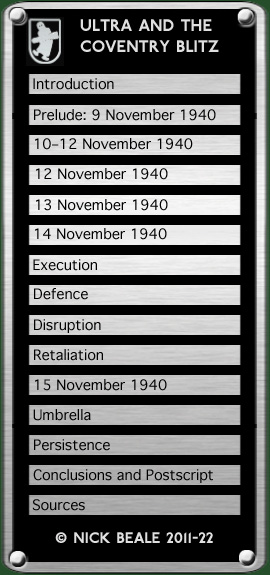|
We’re lucky … when you consider the losses during night take-offs … every second night, and it was the same in all the units—always the same crashes. The machines had little airspeed, they were loaded down and … unresponsive. (Leutnant Max Probst, 2./KG 1) Activity after dark was much heavier than of late, there being several groups in operation. There were the usual references to bomb-dropping etc. without further details being disclosed. (RAF Wireless Intelligence Service, W/T Intelligence and Air Activity Summary No. 438) The Luftwaffe put 449 aircraft over Coventry (the British estimated 330), coming in on routes over Dorset, the Isle of Wight, Sussex, Suffolk and the Wash. The bombs began falling just after 19.00 local time and continued until 06.00 hours. A German intelligence bulletin gives a total of 503 tonnes of high explosive(including 139 bombs of 1000 kg or over) and 881 incendiary containers dropped on the city. The RAF estimated that the attack had been opened by ten KGr. 100 pathfinders (German sources say 13) “which flew up the beams and started fires in the target area. The remaining aircraft then bombed the fires.” With the fully-laden [He 111] we take over an hour to get to 6,000 m … From 6,000–7,000 m. we barely climb at ½ m. a second … If you want to get a “111” up to 7,500, you damn’ well have to pull … the beam doesn’t follow the curvature of the earth and the further you fly on the beam, the higher you have to get. (Leutnant Max Probst, 2./KG 1) When I was flying at night, then KG 100 was always there ahead of us, the so-called fire-raisers. We just said “KG 100 has put the light on.” We just had to fly toward the light. They went in front with incendiaries, phosphorus bombs and so on. (German prisoner in a conversation recorded by CSDIC) In an interrogation report four days after the attack, S/L Felkin of A.I.1(k) wrote: It is known that in the big attack on Coventry … KG 100 were to bomb the centre of the city. Lehrgeschwader 1 were to concentrate on workmen’s dwellings and another Geschwader was to single out the residential districts. Between 15.13 and 21.08 GMT, aircraft using call sign F4G were plotted in various positions between Plymouth and Liverpool; these were, as Ultra had forewarned, KGr. 100’s pathfinders. F4GC signalled that it had bombed the target and was breaking off due to engine trouble; the Gruppenkommandeur’s F4GA reported seeing fires; and at 20.17 hrs. F4GD reported incendiary bombs in the top right of the target area 3 and the bottom right of area 1; traffic was also heard from F4GE. On another frequency, F4GE was heard being guided home to land at Vannes along with L, Z, K and P.
Reports from other German units included a balloon barrage at 1500 metres over the target and 23 large fires. Some 13 machines were heard under “1NW”, most of them reporting dropping their bombs. On a II./KG 2 crew’s second sortie, in the early hours, the column of smoke could be seen from the English coast and the RAF noted that: While earlier raids followed the beams they were soon abandoned by subsequent sorties, which took full advantage of the bright moonlight and approached the objective over a wide front. A lapse in German procedures allowed the British to identify 12 aircraft homing on Le Culot under call sign Q7O as belonging to KG 3. Many more bomber crews announced that they had completed their tasks and were returning home. continued on next page …
|
||||

